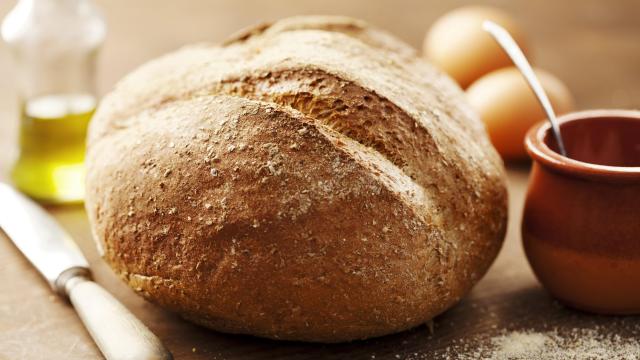Remember that love affair we had with sourdough bread? It was an unusual moment in the sun for yeast. Some folks had extended, public bread-romances on social media, while others had short trysts that wielded little more than a dead starter, graying in the fridge. If you actually got to the baking stage, you probably noticed that nearly all sourdough bread recipes call for cornmeal. Turns out, you don’t need cornmeal to bake a flavorful, rustic loaf, but you do need something gritty.
Parchment has a few drawbacks
Let’s get it out of the way: There’s the parchment paper route. You can technically bypass this whole additional ingredient problem by slapping your proofed and shaped boule onto a sheet of parchment and baking it that way. Your bread will rise and bake, and you can peel the parchment off with ease (because it’s mostly nonstick). But you can run into a few problems. The biggest issue is that parchment can stick to bread, and there’s no telling if it has until your bread has finished baking.
Secondly, most lean doughs (breads that don’t contain butter, sugar or eggs) bake at a high temperature, usually around 260°C or higher. Most parchment papers are rated on the box for up to 200°C or 230°C. When subjected to higher temperatures for extended periods 0f time, parchment paper can scorch, become brittle and start to disintegrate when handled. It’s enough to give you anxiety. Additionally, if you use a Dutch oven to bake your bread, parchment can leave creases or deep furrows baked into the sides. Looks aren’t everything if the flavour is great, but noshing on stuck parchment shreds is just nasty. Besides, why waste parchment when you can use something edible?
Consider oats, seeds, or crushed Corn Flakes
You need a material that creates a barrier between the dough and other surfaces. The ingredient shouldn’t be easily absorbed into the dough, should have a neutral or complementary flavour, and should not melt, burn, or release harmful chemicals at high temperatures. Coarse ground cornmeal is traditionally the loaf buffer of choice because it meets all of these criteria– gritty, neutral flavour, and it doesn’t burn.
If you don’t have cornmeal (or don’t like it), these unusual ingredients will totally work: rolled oats, seeds (hi, everything bagel seasoning), or cereals like crushed Corn Flakes. If you decide to go down the cereal rabbit hole, use plain, dry cereals without fruit or sugary glazes. Fruit will burn and icings can potentially melt in the oven, not to mention they could throw off the flavour.
If you’re making a multigrain bread, it can be a nice touch to reflect the seeds inside your loaf for added texture and flavour. Be sure to use whole seeds, like whole flax seeds, versus ground — seeds and nuts have a lot of naturally occurring oils in them, and when they are ground, these pressed oils are extra susceptible to scorching in the oven.
For similar reasons, you want to avoid anything too finely ground, like flours or even finely ground cornmeal (coarse is preferred). Fine powders quickly absorb into the sticky surface of the dough, which becomes sticky again, prompting you to put even more flour underneath to stop the dough from clinging, which can result in clumping. The pulverised grains can also burn in places, giving you a clumpy coating of flour in every bite.
Don’t let that empty can of cornmeal stop you from rekindling that sordid sourdough affair. You might find you have other ingredients that work just fine, and maybe even make your boule taste better than last year’s.

Leave a Reply
You must be logged in to post a comment.